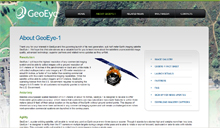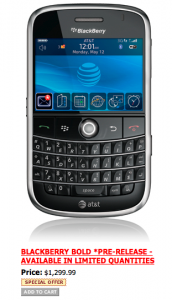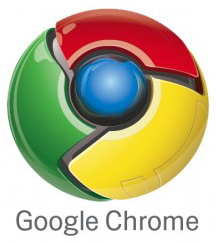Posted by //
Sean
Date and Time //
Sep 8, 08 - 9:02 am
Categories //
Geekery
Google
Technology
Comments Off
 Google has expanded its reach into space with the successful launch Saturday of a new satellite that will provide the company with exclusive images for its maps.
Google has expanded its reach into space with the successful launch Saturday of a new satellite that will provide the company with exclusive images for its maps.
After an 11:50 a.m. takeoff from Vandenberg Air Force Base in California, the GeoEye-1 satellite relayed a downlink signal to a ground station in Norway, confirming that it had separated from its United Launch Alliance Delta II rocket and had begun to initialize its onboard systems.
The satellite launch was coordinated by terrain mapping company GeoEye. “Based upon the data we saw, the satellite is performing properly and ready to begin the next phase towards meeting its mission requirements,” said Bill Schuster, GeoEye chief operating officer, in a statement.
GeoEye said the 4,310-pound satellite required calibration and check-out period before the company would sell its images.
Although GeoEye did not mention Google in any of its announcements regarding the satellite, the search engine giant’s name appeared on the satellite and company founders Sergey Brin and Larry Page attended the launch, according to reports.
GeoEye said it plans to sell the images to customers around the world, but a Google spokesperson said that Google has exclusive rights to the images for commercial maps.
“The imagery from GeoEye-1 adds to the quantity and quality of that currently provided by our IKONOS satellite, and together this magnificent constellation will enable us to meet world-wide customer demand,” Matthew O’Connell, GeoEye CEO, said.
GeoEye-1 is part of the National Geospatial-Intelligence Agency (NGA), NextView program, which aims to obtain timely and accurate commercial satellite imagery.
It will collect 0.41-meter ground resolution black and white images and 1.65-meter color images simultaneously. It can show objects as small as 16 inches. U.S. licensing restrictions limit commercial images to a half-meter ground resolution.
The satellite can capture the images from 423 miles above the Earth and travel about 4.5 miles per second.
General Dynamics Advanced Information Systems in Gilbert, Ariz., built the satellite, while ITT in Rochester, N.Y., developed the imaging system. ITT is building another imaging system for GeoEye-2, which is scheduled to launch in 2011.
GeoEye said it won a $500 million NextView contract four years ago, and it built and launched the satellite with no cost overruns.
Source: GeoEye-1 Launch Site
Posted by //
Sean
Date and Time //
Sep 5, 08 - 6:09 am
Categories //
Apple
Open Source
Software
Technology
Comments Off
 Apple’s iPhone Apps Store approval process clearly has some bugs to work out. Apps will be approved, and then pulled. Some bad apps remain in the store, while others aren’t approved at all.
Apple’s iPhone Apps Store approval process clearly has some bugs to work out. Apps will be approved, and then pulled. Some bad apps remain in the store, while others aren’t approved at all.
The latest casualty is an application that, well, I probably shouldn’t publish what it does here in the first paragraph, but Beavis and Butt-head would have loved it.
The rejected application is called iFartz. I think you can figure out for yourself what the application does. The rejection letter was sent to the application’s developer by an Apple employee named Victor Wang.
According to The Unofficial Apple Weblog, Mr. Wang is “a near legend for his rejection letters, usually long, delayed, and for aesthetic reasons that leave developers blinking with surprise.”
But, really. Is anyone surprised that an application called iFartz, which has what Apple called “limited utility,” wasn’t approved? I’m not surprised. Much.
TUAW writer Erica Sadun calls iFartz “a simple, stupid joke app … but it’s the kind of simple, stupid joke app that a lot of people would download and use because people like simple, stupid joke apps.”
The author of iFartz has taken his case online. He set up a Web page begging (and scolding) Apple. On that page, he wrote:
“Sure, the App Store makes it nice and easy to find, purchase, and install iPhone applications, but is it worth the cost of a single authority telling us what they think adds utility? Ironically, if ‘limited utility’ was a factor by which we judged all software development, Mac OS probably would have died in the ’90s. At the very least, we can show Apple they’re wrong, that there’s a demand for Pull My Finger. Join this campaign pledging to spend up to $0.99 cents if PMF is accepted to the iTunes store.”
But Sadun says it better. She writes:
“Until Apple offers developers a firm set of guidelines, developers will continue to be ticked off by seemingly arbitrary rejections like this one. Apple needs to step forward, and do so soon, with a clear set of guidelines that explain to developers exactly what to expect when they press that ‘submit’ button for their new app. Developers shouldn’t be wasting Apple’s time with unpublishable software. Apple should not be wasting Developers’ time with a secretive and arbitrary review process.”
Until Apple does send out a usable set of guidelines for developers, we’ll have to abide by its sense of what’s good and what isn’t, rather than let us determine for ourselves.
Apple, can’t you let the free market decide?
Posted by //
Sean
Date and Time //
Sep 4, 08 - 6:45 am
Categories //
Technology
Toys & Gadgets
Wireless
Comments Off
 An enterprising company with a retail location in mid-town Manhattan managed to get its hands on five pre-release versions of the much-coveted BlackBerry Bold.
An enterprising company with a retail location in mid-town Manhattan managed to get its hands on five pre-release versions of the much-coveted BlackBerry Bold.
What did it do? Put them up for sale, naturally. The price tag? A staggering $1,300.00 USD. For that, you get a phone that may or may not be fully optimized forAT&T (NYSE: T)’s network.
The BlackBerry Bold, RIM’s next-generation smartphone, was supposed to go on sale back in July. Then the date was pushed to August. The initial reason behind the delay was supposed network-related issues.
Here we are in September, and still no BlackBerry Bold.
At this point, no one appears to know exactly when the device will officially hit the streets. Some reports suggest that it will be early October before we see it. That is, of course, unconfirmed.
Despite its lack of official availability here in the US, it has gone on sale in Canada and elsewhere and, some how, the New York BlackBerry Center got its hands of five of the smartphones over the weekend.
The company, located in the Time Life Building on 6th Ave at West 50th Street in Manhattan, decided to sell their stock at a price only a banker could afford.
It sold all five for $1,300.00 USD each. Wow. That’s a heck of a mark-up. To those five who purchased them, good luck with your pre-release hardware!
Posted by //
Sean
Date and Time //
Sep 1, 08 - 12:58 pm
Categories //
Google
Open Source
Software
Technology
Comments Off
 Yes, you read that correctly. Google is taking a major swipe at its competitors with the imminent launch of Chrome, a new Web browser based on Webkit, thus marks the beginning of a new phase in the browser wars.
Yes, you read that correctly. Google is taking a major swipe at its competitors with the imminent launch of Chrome, a new Web browser based on Webkit, thus marks the beginning of a new phase in the browser wars.
Kara Swisher at All Things Digital got perhaps one of the biggest scoops of the year. She spoke to some people familiar with some of the projects Google is working on.
Those sources say that Google is set to unveil a brand new Web browser that will be available to everyone as early as tomorrow (Tuesday).
Not only is Google going announcing a new browser, but it is making the announcement with a comic book. That’s hot.
Google has talked the browser talk for years. The last time I heard anything formal about it from the Google camp was nearly a year ago. Looks like Google is ready to walk the browser walk with Chrome.
Here are some details about what makes Chrome so great, as relayed by Blogoscoped.
Chrome is an open source browse based on Webkit. It will include aspects of Google’s Gears. It will include a JavaScript Virtual Machine that is being dubbed “V8”. This virtual machine, built by a bunch of coders in Denmark, can be embedded within another browser. It will also help render pages faster.
Google is taking some features from Firefox, such as the tabs, and adding its own spin, placing them above the address bar rather than below it. The address bar will have an auto-complete feature, much like that of Firefox. The Chrome browser home page will offer a speed-dial feature, similar to the one seen on Opera’s desktop browser.
My favorite feature is that Chrome will have a “privacy” mode. Surfing with the privacy setting enabled will create a new browsing window and allow you to browse with no history of what occurs in that window being stored on the computer. In other words, you can browse sites and no one will be able to track down where you’ve been on that machines.
A few other things include the ability to launch Web applications in their own browser window, absent the address bar, and tools to help fight malware and phishing.
This all sounds amazing so far. Google appears to be taking some of the great features of Firefox and Opera, merging them, and setting it up as an open source project.
Microsoft’s Internet Explorer still has the lion’s share of the market. Firefox and, to a lesser extent, Opera, have put a dent in that marketshare. Neither, however, has matched Microsoft.
How will Chrome compare? Can it stand up to such weathered competition? Will it really take marketshare away from Microsoft, or will it bleed users away from Firefox and Opera?
Only time will answer those questions. Until then, I am looking forward to taking Chrome for a test spin.
Who knew that puppets could thrash harder than humans?
Posted by //
Sean
Date and Time //
Aug 26, 08 - 7:16 pm
Categories //
Gaming
Humor
Technology
Videos
Comments Off
Here’s a great video that spoofs Republican presidential contender John McCain with a little Nintendo 8-bit, classic gaming flair: